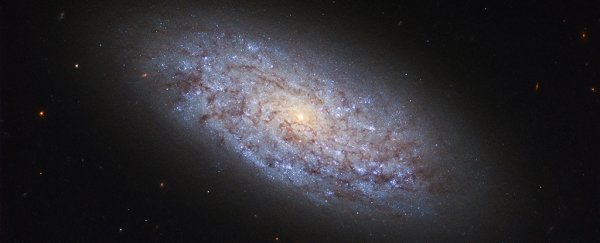Dark matter is one slippery substance. As far as we can tell, it has to exist for our current models of the Universe to work. But not only can we not see it, feel it, or interact with it in any way – we're not even sure what dark matter really is.
We do have some clues though, like how dark matter can interact or 'talk' to regular matter via gravity. The way these interactions work is still a mystery, but a new paper proposes that something called 'non-minimal coupling' could be the solution.
"We asked ourselves: is gravity wrong or are we just missing something crucial about dark matter's nature? What if dark matter and standard 'baryonic' matter do not communicate in the way we have always imagined?" the three authors, cosmologists Giovanni Gandolfi, Andrea Lapi and Stefano Liberati, explain in a press statement on their work.
"With our research, we have tried to answer these intriguing questions."
Our best guess about what dark matter might be is cold, weakly interacting massive particles, which experimental physicists around the world have been trying to detect for decades, but haven't yet found.
Despite how well this particular type of dark matter works in our models, there are still a couple of issues. A big one is called the cuspy halo problem, where the inferred density of dark matter in galaxies doesn't line up with what's known as N-body simulations.
These simulations suggest that to explain their current structure and movement, in low-matter galaxies dark matter should be 'cuspy' – meaning it's most concentrated around the cusp or outside of the galaxy. But observations tell us that most dwarf galaxies seem to hold their dark matter in the middle.
This paper is definitely not the first, and likely won't be the last to try and solve these dark matter issues, but the team has proposed a new tactic. The researchers suggest that if dark matter is non-minimally coupled to gravity, it solves the cuspy issue and another related problem called radial acceleration relation.
"In this paper, we propose yet another viewpoint to modify the standard cold dark matter framework and make it capable of accurately describing the observed galaxy rotation curves and at the same time to faithfully reproduce the radial acceleration relation," the team writes in their new paper.
"Introducing such a coupling can retain the success of the cold dark matter on large cosmological scales while improving its behavior in galactic systems."
Non-minimal coupling is a bit of a misnomer. It means that the dark matter is directly coupled to a curvature in spacetime called the Einstein tensor. Simply put, it's a new type of interaction between dark matter and gravity. If non-minimal coupling is happening, the dark matter interacts with spacetime in a different way than regular matter does.
"This feature of dark matter is not a piece of new exotic fundamental physics," the authors say.
"One can explain the existence of this non-minimal coupling with known physics alone".
This is just one hypothesis, and although it seems to fit well with the observational data we have so far, dark matter is still a complicated beast. We'll need much more research to determine if non-minimal coupling actually is a feature of dark matter or just another hypothesis that pushes us forward to discover what's really going on.
"The future of dark matter looks brighter," the authors note in a press statement.
"Further studies will be carried out to explore all the interesting implications of this proposed new feature of dark matter. We wouldn't be surprised to discover that this non-minimal coupling could solve other unanswered questions of the Universe."
The research has been published in The Astrophysical Journal.
